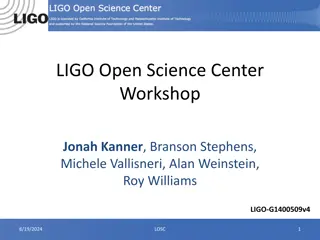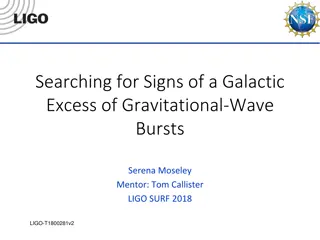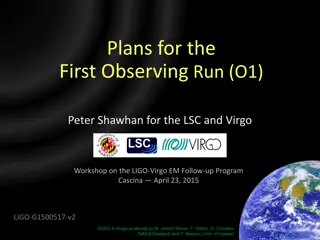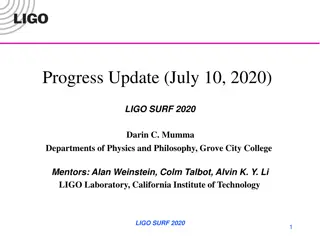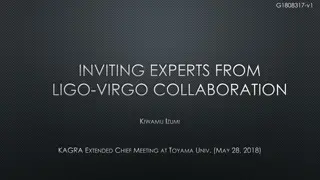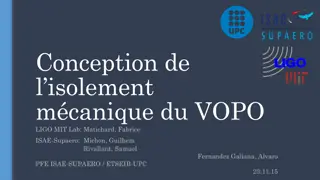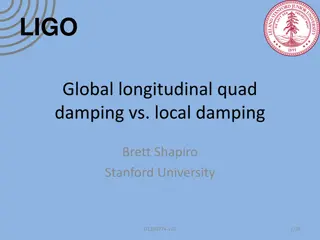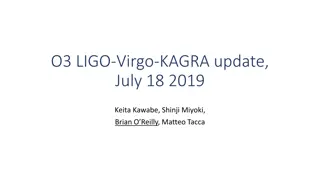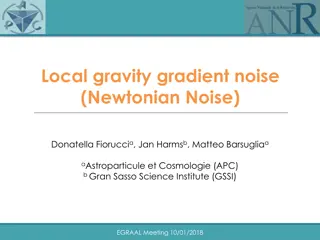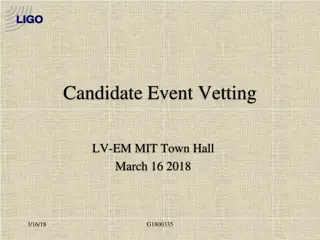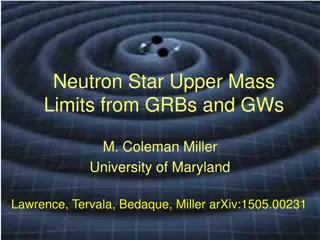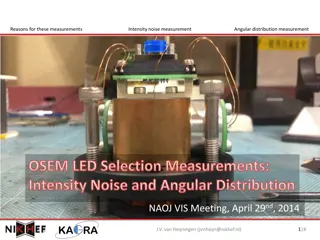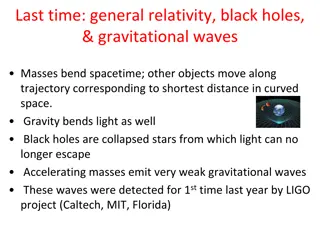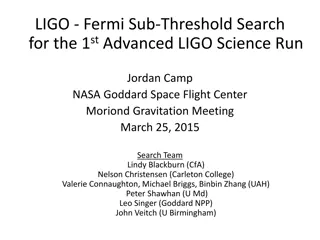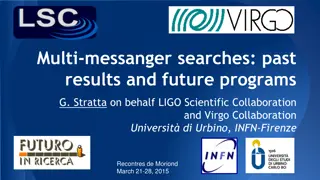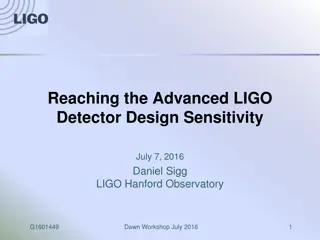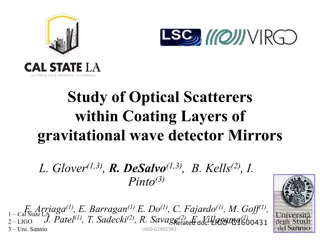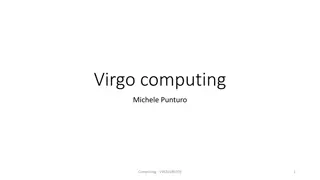Unlocking LIGO Data with Ease at LIGO Open Science Center Workshop
Dive into accessing LIGO data effortlessly at the LIGO Open Science Center Workshop. Learn about software setup, finding data with Timeline, and accessing valuable resources for new students and experienced researchers alike. Explore complete documentation, tutorials, and compatibility with various
0 views • 27 slides
Unveiling Galactic Excess in Gravitational-Wave Bursts
Investigate the presence of a galactic source emitting gravitational waves within the LIGO frequency range and develop techniques to detect and identify these signals. Employ simulations to differentiate between isotropic and galactic event distributions, aiming to enhance our understanding of the o
0 views • 30 slides
Observing Run O1: The Big Picture and Event Candidate Selection
Plans for the First Observing Run (O1) in the LIGO-Virgo EM Follow-up Program involving GEO 600, LIGO Hanford, KAGRA, Virgo, LIGO Livingston, and LIGO-India. Details on data transfer, quality validation, event candidate selection, preliminary alerts, interpretation, updated information, and validati
0 views • 15 slides
LIGO SURF 2020 Progress Update Summary
This progress update on LIGO SURF 2020 by Darin C. Mumma from the Departments of Physics and Philosophy at Grove City College includes frequency domain plots, early BILBY output, questions, and next steps. It explores organizing windows for frequency domain transform and different window types, as w
0 views • 13 slides
Planning for Commissioning Experts Exchange Program
Initiating discussions on inviting experts from LIGO-Virgo Collaboration to assist with commissioning activities at KAGRA. Budget sources and possible programs identified. Key considerations include determining who to invite, when, and how to apply for the exchange program. Past experiences with Vir
0 views • 6 slides
Mechanical Isolation Design of Vopo LIGO MIT Lab
The project details the mechanical isolation design for the Vopo LIGO at MIT Lab, covering aspects such as suspension analysis, optical table optimization, and conclusions. It focuses on the seismic isolation of aLIGO, featuring vacuum chambers and CAD models of the suspensions. The concept includes
0 views • 38 slides
LIGO Global vs. Local Damping Study
LIGO conducted a study comparing global and local damping effects in their system. The research delved into common arm length damping, differential arm length dynamics, and simulated common length damping scenarios. Various configurations and sensor noise considerations were explored to understand t
0 views • 62 slides
Update on O3 LIGO-Virgo-KAGRA Project and Commissioning Plan Milestones
Updates on the O3 LIGO-Virgo-KAGRA project, including detector performance, alerts, retractions, and the upcoming commissioning break. The status and milestones of KAGRA commissioning plan are also outlined, with details on noise hunting, beam alignment, cooling systems, and other key activities.
0 views • 8 slides
Understanding Newtonian Noise in Gravity Gradient Measurements
Investigating the impact of Newtonian Noise (NN) on various detectors and instruments used for measuring gravity gradients. The content delves into the frequency ranges affected by NN in detectors like LIGO, AdVirgo, and KAGRA, as well as the influence of infrasound and seismic waves. The discussion
0 views • 17 slides
Scaling Condor on XSEDE for LIGO - Collaborative Computing Project
The project aims to evaluate the utilization of XSEDE resources by LIGO for large-scale computing tasks, with a focus on distributed computing challenges and fostering a research computing community. Various aspects such as political, cultural, and technical narratives surrounding the collaboration
0 views • 28 slides
Event Vetting Process and Rapid Response Teams at LIGO-Virgo Collaboration
The LIGO-Virgo Collaboration utilizes a comprehensive event vetting process involving Rapid Response Teams to assess the quality of alerts and potential events. The teams, consisting of site advocates, experts, and operators, convene online to either retract or promote alerts based on their quality.
0 views • 8 slides
Neutron Star Upper Mass Limits from GRBs and GWs Research Insights
Analysis of neutron star upper mass limits derived from gamma-ray bursts (GRBs) and gravitational waves (GWs), indicating constraints on mass thresholds for NS-NS or NS-BH mergers. The study explores implications for LIGO detection rates, jet behaviors, and collapse scenarios. Future work suggestion
0 views • 5 slides
Understanding Intensity Noise and Angular Distribution Measurements in LED Selection
The measurements focus on intensity noise and angular distribution to address variations in LED performance observed in LIGO papers. The study aims to investigate intensity noise dependence on LED current, differences between LED batches, and comparisons between them.
0 views • 8 slides
Insights into General Relativity, Black Holes, and Gravitational Waves
Masses bending spacetime, black holes trapping light, and the detection of gravitational waves by LIGO have revolutionized our understanding of the universe. From Eddington's 1919 experiment confirming light bending to Hubble's discovery of an expanding universe, key milestones in cosmology have res
0 views • 24 slides
Neural Network Control for Seismometer Temperature Stabilization
Utilizing neural networks, this project aims to enhance seismometer temperature stabilization by implementing nonlinear control to address system nonlinearities. The goal is to improve control performance, decrease overshoot, and allow adaptability to unpredictable parameters. The implementation of
0 views • 24 slides
Advanced LIGO and Short Gamma-Ray Burst Search Overview
Advanced LIGO is focused on achieving a lower noise level and higher sensitivity to detect gravitational waves. The search involves analyzing data from the 1st Advanced LIGO Science Run, collaboration with Fermi, and seeking coincident detections of gravitational waves and gamma-ray bursts, particul
0 views • 13 slides
Multi-Messenger Searches for Transient Astrophysical Sources
This talk reviews three classes of transient astrophysical sources capable of producing gravitational wave (GW) signals in the LIGO and Virgo frequency range. These sources include coalescence of neutron star (NS) and black hole (BH) binary systems, core collapsing stars, and flaring/bursting NSs. T
0 views • 38 slides
Challenges and Plans for Reaching Advanced LIGO Detector Sensitivity
The presentation outlines the challenges and strategies for enhancing the sensitivity of the Advanced LIGO detector. It discusses the plan to interleave commissioning with observation runs, set sensitivity goals for early runs, and address major challenges like low-frequency noise and increasing las
0 views • 15 slides
Understanding Mechanical Quality Factor of Cryogenic Silicon
This presentation explores the Mechanical Quality Factor of Cryogenic Silicon, detailing its significance in improving LIGO detectors by minimizing thermal elastic noise. The Fluctuation-Dissipation Theorem is discussed, showing how it relates noise spectrum to linear system responses. Methods for m
0 views • 18 slides
Study of Optical Scatterers Within Coating Layers of Gravitational Wave Detector Mirrors
Analyzing scattering points within Advanced LIGO mirror coatings revealed unexpected weak scatterers, potentially influencing energy losses and thermal noise in gravitational wave detectors. Individual scatterers were identified using DAOPHOT, an algorithm originally created for astronomy, to pinpoi
0 views • 23 slides
Overview of Virgo Computing Activities
Virgo computing has been a hot topic recently, with various discussions and meetings focusing on computing issues, future developments in astroparticle computing, and funding for INFN experiments. The activities include presentations, committee meetings, talks, and challenges in computing faced by V
0 views • 34 slides
